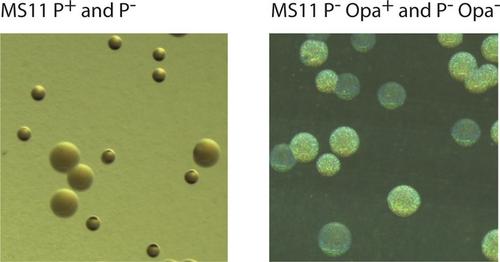{"title":"淋病奈瑟菌和共生奈瑟菌种的基因操作。","authors":"Joseph P. Dillard, Jia Mun Chan","doi":"10.1002/cpz1.70000","DOIUrl":null,"url":null,"abstract":"<p>The sexually transmitted pathogen, <i>Neisseria gonorrhoeae</i>, undergoes natural transformation at high frequency. This property has led to the rapid dissemination of antibiotic resistance markers and the panmictic structure of the gonococcal population. However, high-frequency transformation also makes <i>N. gonorrhoeae</i> one of the easiest bacterial species to manipulate genetically in the laboratory. Techniques have been developed that result in transformation frequencies >50%, allowing the identification of mutants by screening and without selection. Constructs have been created to take advantage of this high-frequency transformation, facilitating genetic mutation, complementation, and heterologous gene expression. Similar methods have been developed for <i>N. meningitidis</i> and nonpathogenic <i>Neisseria</i> including <i>N. mucosa</i> and <i>N. musculi</i>. Techniques are described for genetic manipulation of <i>N. gonorrhoeae</i> and commensal <i>Neisseria</i> species, as well as for growth of these fastidious organisms. © 2024 The Author(s). Current Protocols published by Wiley Periodicals LLC.</p><p><b>Basic Protocol 1</b>: Spot transformation of <i>Neisseria gonorrhoeae</i> on agar plates</p><p><b>Basic Protocol 2</b>: Spot transformation of commensal <i>Neisseria</i> on agar plates</p><p><b>Basic Protocol 3</b>: Transformation of <i>Neisseria gonorrhoeae</i> in liquid culture</p><p><b>Basic Protocol 4</b>: Electroporation of <i>Neisseria gonorrhoeae</i></p><p><b>Basic Protocol 5</b>: Creation of unmarked mutations using a positive and negative selection cassette</p><p><b>Basic Protocol 6</b>: In vitro mutagenesis of <i>Neisseria gonorrhoeae</i> chromosomal DNA using EZ-Tn5</p><p><b>Basic Protocol 7</b>: Chemical mutagenesis</p><p><b>Basic Protocol 8</b>: Complementation on the <i>Neisseria gonorrhoeae</i> chromosome</p><p><b>Alternate Protocol 1</b>: Complementation with replicating plasmids</p><p><b>Alternate Protocol 2</b>: Complementation on the <i>Neisseria musculi</i> or <i>Neisseria mucosa</i> chromosome</p><p><b>Basic Protocol 9</b>: Preparation of chromosomal DNA from <i>Neisseria gonorrhoeae</i> grown on solid medium</p><p><b>Alternate Protocol 3</b>: Preparation of chromosomal DNA from <i>Neisseria gonorrhoeae</i> grown in broth</p><p><b>Support Protocol</b>: Preparing PCR templates from <i>Neisseria gonorrhoeae</i> colonies</p>","PeriodicalId":93970,"journal":{"name":"Current protocols","volume":"4 9","pages":""},"PeriodicalIF":0.0000,"publicationDate":"2024-09-04","publicationTypes":"Journal Article","fieldsOfStudy":null,"isOpenAccess":false,"openAccessPdf":"https://onlinelibrary.wiley.com/doi/epdf/10.1002/cpz1.70000","citationCount":"0","resultStr":"{\"title\":\"Genetic Manipulation of Neisseria gonorrhoeae and Commensal Neisseria Species\",\"authors\":\"Joseph P. Dillard, Jia Mun Chan\",\"doi\":\"10.1002/cpz1.70000\",\"DOIUrl\":null,\"url\":null,\"abstract\":\"<p>The sexually transmitted pathogen, <i>Neisseria gonorrhoeae</i>, undergoes natural transformation at high frequency. This property has led to the rapid dissemination of antibiotic resistance markers and the panmictic structure of the gonococcal population. However, high-frequency transformation also makes <i>N. gonorrhoeae</i> one of the easiest bacterial species to manipulate genetically in the laboratory. Techniques have been developed that result in transformation frequencies >50%, allowing the identification of mutants by screening and without selection. Constructs have been created to take advantage of this high-frequency transformation, facilitating genetic mutation, complementation, and heterologous gene expression. Similar methods have been developed for <i>N. meningitidis</i> and nonpathogenic <i>Neisseria</i> including <i>N. mucosa</i> and <i>N. musculi</i>. Techniques are described for genetic manipulation of <i>N. gonorrhoeae</i> and commensal <i>Neisseria</i> species, as well as for growth of these fastidious organisms. © 2024 The Author(s). Current Protocols published by Wiley Periodicals LLC.</p><p><b>Basic Protocol 1</b>: Spot transformation of <i>Neisseria gonorrhoeae</i> on agar plates</p><p><b>Basic Protocol 2</b>: Spot transformation of commensal <i>Neisseria</i> on agar plates</p><p><b>Basic Protocol 3</b>: Transformation of <i>Neisseria gonorrhoeae</i> in liquid culture</p><p><b>Basic Protocol 4</b>: Electroporation of <i>Neisseria gonorrhoeae</i></p><p><b>Basic Protocol 5</b>: Creation of unmarked mutations using a positive and negative selection cassette</p><p><b>Basic Protocol 6</b>: In vitro mutagenesis of <i>Neisseria gonorrhoeae</i> chromosomal DNA using EZ-Tn5</p><p><b>Basic Protocol 7</b>: Chemical mutagenesis</p><p><b>Basic Protocol 8</b>: Complementation on the <i>Neisseria gonorrhoeae</i> chromosome</p><p><b>Alternate Protocol 1</b>: Complementation with replicating plasmids</p><p><b>Alternate Protocol 2</b>: Complementation on the <i>Neisseria musculi</i> or <i>Neisseria mucosa</i> chromosome</p><p><b>Basic Protocol 9</b>: Preparation of chromosomal DNA from <i>Neisseria gonorrhoeae</i> grown on solid medium</p><p><b>Alternate Protocol 3</b>: Preparation of chromosomal DNA from <i>Neisseria gonorrhoeae</i> grown in broth</p><p><b>Support Protocol</b>: Preparing PCR templates from <i>Neisseria gonorrhoeae</i> colonies</p>\",\"PeriodicalId\":93970,\"journal\":{\"name\":\"Current protocols\",\"volume\":\"4 9\",\"pages\":\"\"},\"PeriodicalIF\":0.0000,\"publicationDate\":\"2024-09-04\",\"publicationTypes\":\"Journal Article\",\"fieldsOfStudy\":null,\"isOpenAccess\":false,\"openAccessPdf\":\"https://onlinelibrary.wiley.com/doi/epdf/10.1002/cpz1.70000\",\"citationCount\":\"0\",\"resultStr\":null,\"platform\":\"Semanticscholar\",\"paperid\":null,\"PeriodicalName\":\"Current protocols\",\"FirstCategoryId\":\"1085\",\"ListUrlMain\":\"https://onlinelibrary.wiley.com/doi/10.1002/cpz1.70000\",\"RegionNum\":0,\"RegionCategory\":null,\"ArticlePicture\":[],\"TitleCN\":null,\"AbstractTextCN\":null,\"PMCID\":null,\"EPubDate\":\"\",\"PubModel\":\"\",\"JCR\":\"\",\"JCRName\":\"\",\"Score\":null,\"Total\":0}","platform":"Semanticscholar","paperid":null,"PeriodicalName":"Current protocols","FirstCategoryId":"1085","ListUrlMain":"https://onlinelibrary.wiley.com/doi/10.1002/cpz1.70000","RegionNum":0,"RegionCategory":null,"ArticlePicture":[],"TitleCN":null,"AbstractTextCN":null,"PMCID":null,"EPubDate":"","PubModel":"","JCR":"","JCRName":"","Score":null,"Total":0}
引用次数: 0
Genetic Manipulation of Neisseria gonorrhoeae and Commensal Neisseria Species
The sexually transmitted pathogen, Neisseria gonorrhoeae, undergoes natural transformation at high frequency. This property has led to the rapid dissemination of antibiotic resistance markers and the panmictic structure of the gonococcal population. However, high-frequency transformation also makes N. gonorrhoeae one of the easiest bacterial species to manipulate genetically in the laboratory. Techniques have been developed that result in transformation frequencies >50%, allowing the identification of mutants by screening and without selection. Constructs have been created to take advantage of this high-frequency transformation, facilitating genetic mutation, complementation, and heterologous gene expression. Similar methods have been developed for N. meningitidis and nonpathogenic Neisseria including N. mucosa and N. musculi. Techniques are described for genetic manipulation of N. gonorrhoeae and commensal Neisseria species, as well as for growth of these fastidious organisms. © 2024 The Author(s). Current Protocols published by Wiley Periodicals LLC.
Basic Protocol 1: Spot transformation of Neisseria gonorrhoeae on agar plates
Basic Protocol 2: Spot transformation of commensal Neisseria on agar plates
Basic Protocol 3: Transformation of Neisseria gonorrhoeae in liquid culture
Basic Protocol 4: Electroporation of Neisseria gonorrhoeae
Basic Protocol 5: Creation of unmarked mutations using a positive and negative selection cassette
Basic Protocol 6: In vitro mutagenesis of Neisseria gonorrhoeae chromosomal DNA using EZ-Tn5
Basic Protocol 7: Chemical mutagenesis
Basic Protocol 8: Complementation on the Neisseria gonorrhoeae chromosome
Alternate Protocol 1: Complementation with replicating plasmids
Alternate Protocol 2: Complementation on the Neisseria musculi or Neisseria mucosa chromosome
Basic Protocol 9: Preparation of chromosomal DNA from Neisseria gonorrhoeae grown on solid medium
Alternate Protocol 3: Preparation of chromosomal DNA from Neisseria gonorrhoeae grown in broth
Support Protocol: Preparing PCR templates from Neisseria gonorrhoeae colonies


